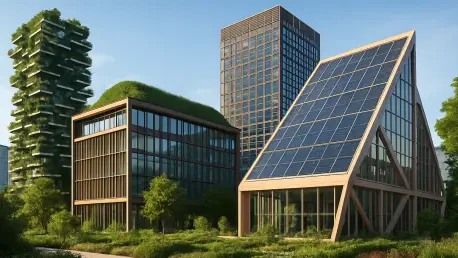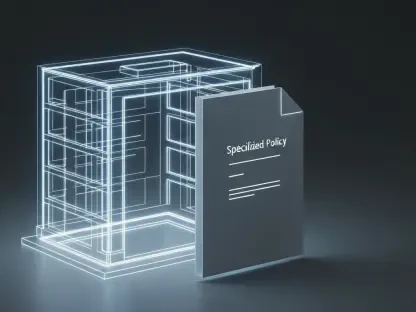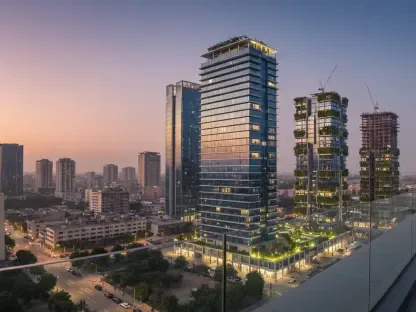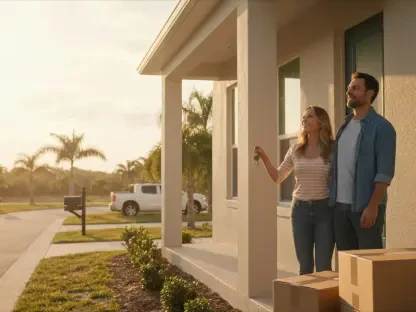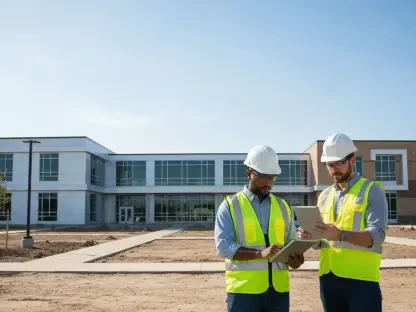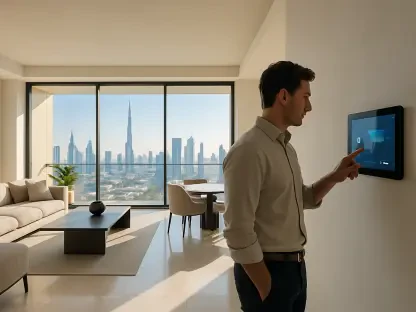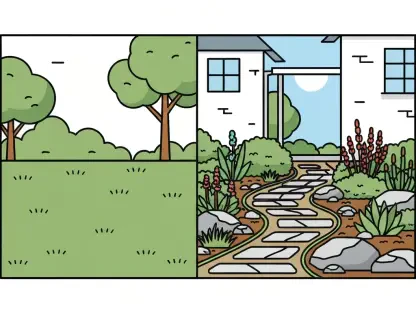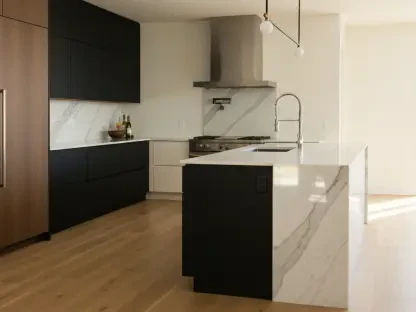In a landmark moment for sustainable construction, the U.S. Green Building Council (USGBC) has announced the certification of the first projects under the innovative LEED v5 (Leadership in Energy and Environmental Design) program, signaling a new era in green building standards. This latest iteration of the globally recognized rating system emphasizes resilience, occupant health, and significant environmental impact reduction, setting a bold precedent for the industry. Revealed on August 21, 2025, this milestone showcases an impressive array of pioneering structures that embody the future of eco-friendly design and operation across diverse international landscapes. These projects are not merely buildings but symbols of a collective commitment to tackling pressing global challenges like climate change and resource scarcity. Their certification under LEED v5 highlights a unified vision for sustainability, inspiring others to follow suit in creating spaces that prioritize both the planet and the people who inhabit them.
Spanning Continents with Sustainable Design
The initial wave of LEED v5 certifications encompasses 14 remarkable projects, collectively spanning over 12 million square feet of space across nine countries in North and South America, Europe, Asia, and the Middle East. This wide geographic spread illustrates the universal applicability of the rating system, with certified structures ranging from retail spaces like Portobello Shop Jardim Social in Brazil, which earned Platinum status as the first globally certified project, to iconic high-rises such as TAIPEI 101 in Taiwan, now the tallest building under this new standard. The diversity in building types—encompassing offices, warehouses, and sports venues—further underscores how sustainability can be seamlessly integrated into varied contexts. Each project reflects a shared dedication to environmental stewardship, proving that green building principles can thrive regardless of cultural or regional differences, and setting a powerful benchmark for global construction practices.
Beyond their geographic diversity, these projects highlight the adaptability of LEED v5 to meet the unique needs of different sectors and communities worldwide. From the historic charm of Frascati, Italy, with the Platinum-certified Gianni Giorgi-Alberti, to the bustling commercial hub of Hong Kong with the International Commerce Centre, the largest certified project globally, the system’s flexibility shines through. This broad application across urban and industrial landscapes demonstrates a growing consensus on the importance of sustainable design as a fundamental aspect of modern architecture. The achievement of such varied certifications signals a transformative shift in how buildings are conceived and operated, encouraging stakeholders in every corner of the world to embrace practices that reduce environmental footprints while enhancing the quality of life for occupants. This global rollout is a testament to the unifying power of sustainability goals.
Pioneering Innovation in Green Building
These LEED v5 certified projects stand as trailblazers, not just for meeting stringent sustainability criteria but for actively shaping the evolution of the rating system itself. Many of these initiatives, engaged as early adopters since 2023, provided essential feedback that refined the framework, ensuring it addresses real-world challenges in building design and operations. Their role in this iterative process showcases a spirit of innovation, pushing the boundaries of what constitutes a high-performing, resilient structure. For instance, projects like BranchPattern Omaha in Nebraska, which secured Platinum certification, exemplify cutting-edge approaches to green office spaces. This collaborative dynamic between project teams and USGBC highlights a shared mission to elevate industry standards, demonstrating that leadership in sustainability requires both vision and a willingness to adapt and improve.
Moreover, the pioneering nature of these projects serves as an inspiration for future developments in the construction sector, illustrating that ambitious sustainability goals are within reach. The certification of diverse structures, such as the Xfinity Mobile Arena in Philadelphia, the first sports and entertainment venue under LEED v5 with Gold status, proves that innovation can extend beyond traditional building types. This forward-thinking approach not only addresses immediate environmental concerns but also sets a precedent for long-term resilience in the face of evolving climate challenges. By leading with actionable insights and measurable outcomes, these projects encourage other developers and architects to rethink conventional practices, fostering a culture of continuous improvement. Their success under LEED v5 is a clear signal that the industry can achieve extraordinary results through dedication and creative problem-solving.
Tackling Carbon Emissions Head-On
At the heart of LEED v5 lies a critical focus on decarbonization, a priority that accounts for half of the available certification points and directly confronts the built environment’s substantial contribution to global carbon emissions, estimated at 40% by the UN Environment Programme. With building operations alone responsible for 27% of these emissions, the certified projects play a vital role in reducing energy consumption and operational costs while steering toward net-zero goals. This emphasis aligns with urgent global efforts to mitigate climate change through smarter, more efficient building practices. Structures like Torre Diana in Mexico City, which earned Platinum certification, exemplify how sustainable office design can significantly lower carbon footprints, offering a model for others to emulate in addressing one of the most pressing environmental issues of the era.
The commitment to energy efficiency in these projects extends beyond mere compliance, reflecting a deeper understanding of the long-term benefits of sustainable operations. By integrating advanced technologies and design strategies, such as those seen in Tlalnepark IV Nave 2 in Mexico, the first warehouse certified under LEED v5 with Gold status, these buildings demonstrate tangible reductions in utility expenses and environmental impact. This focus on decarbonization not only addresses immediate ecological concerns but also positions the certified projects as key players in the broader movement toward a low-carbon future. As more buildings adopt such practices, the cumulative effect could reshape the industry’s contribution to global emissions, proving that strategic design choices can yield significant progress. The LEED v5 framework thus serves as a crucial tool in driving this transformative change across diverse building sectors.
Enhancing Lives Through Sustainable Spaces
LEED v5 goes beyond environmental targets to prioritize the health and well-being of building occupants, creating spaces that nurture both the planet and its people. This human-centric approach is evident in projects like Portobello Shop Jardim Social in Brazil, which achieved Platinum certification by optimizing energy and water management while ensuring a comfortable, healthy environment for visitors and staff. Such initiatives highlight how sustainable design can directly enhance quality of life, addressing factors like indoor air quality and access to natural light. This dual focus on ecological and personal benefits represents a holistic vision of green building, where the needs of individuals are considered alongside broader environmental goals, setting a new standard for what buildings can achieve.
Furthermore, the emphasis on occupant well-being in LEED v5 certifications signals a shift in how the industry values the human experience within built environments. Projects like Ascent MKE in Milwaukee, Wisconsin, certified at the Silver level, show that even residential and mixed-use developments can integrate features that promote health alongside sustainability. This balance ensures that buildings are not just structures but vibrant spaces that support the physical and mental wellness of those who use them. By championing such principles, these certified projects challenge traditional notions of construction, urging developers to consider the broader impact of their work on community vitality. The result is a growing recognition that sustainable buildings must serve as sanctuaries for both the environment and human life, reinforcing the importance of this integrated approach in future designs.
Setting the Bar with Platinum Excellence
A striking feature of the first LEED v5 certifications is the high number of projects achieving Platinum status, the pinnacle of sustainability recognition, with over half of the 14 projects reaching this level. This remarkable trend indicates an exceptional commitment to surpassing basic requirements and striving for the highest benchmarks in green performance. Projects like Sarona Tower in Tel Aviv, Israel, the first in the Middle East to earn Platinum certification, reflect a competitive drive among teams to excel in environmental responsibility. This pursuit of excellence suggests that green certifications are increasingly viewed as a prestigious marker of quality in the construction and real estate sectors, signaling a cultural shift toward prioritizing sustainability as a core value in building development.
This wave of Platinum achievements also underscores the rigorous standards embedded in LEED v5, challenging the industry to aim for top-tier outcomes rather than settling for minimal compliance. The success of projects like Kvarngärdet 1:19 Tornet in Uppsala, Sweden, another Platinum recipient, demonstrates that even in varied regional contexts, the highest levels of sustainability are attainable with dedication and innovative strategies. Such accomplishments elevate the expectations for future certifications, pushing other stakeholders to invest in practices that yield significant environmental and economic benefits. This trend of striving for the best possible results fosters a sense of accountability and ambition, ensuring that the momentum for green building continues to grow. As more projects follow this path, the collective impact on global sustainability efforts will likely intensify, shaping a more responsible and forward-thinking industry.
Reflecting on a Milestone in Green Progress
Looking back, the announcement of the first LEED v5 certified projects by the U.S. Green Building Council marked a defining moment in the journey toward sustainable construction. Spanning multiple continents and diverse building types, these 14 trailblazing initiatives demonstrated a profound global commitment to reducing environmental impact while prioritizing occupant well-being. The emphasis on decarbonization and the prevalence of Platinum certifications reflected an industry eager to exceed expectations and tackle pressing climate challenges head-on. As the rollout of LEED v5 continues, with further certifications for operations and maintenance projects anticipated in the coming months, the path forward involves scaling these successes to inspire broader adoption. Encouraging existing structures to integrate similar strategies, alongside fostering collaboration among stakeholders, will be crucial in amplifying the impact of this groundbreaking standard on the future of building design worldwide.
